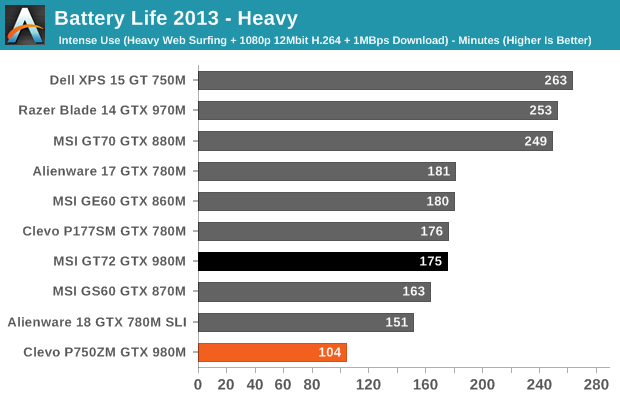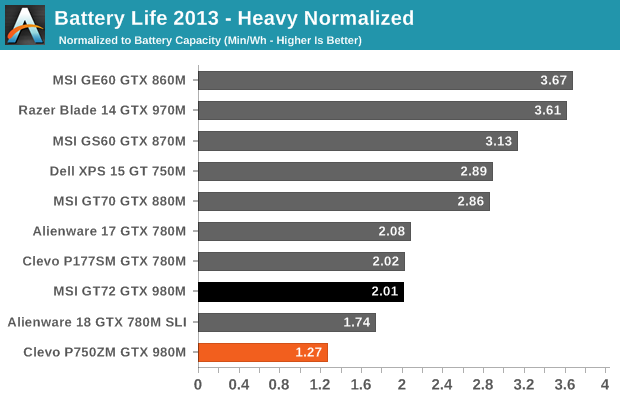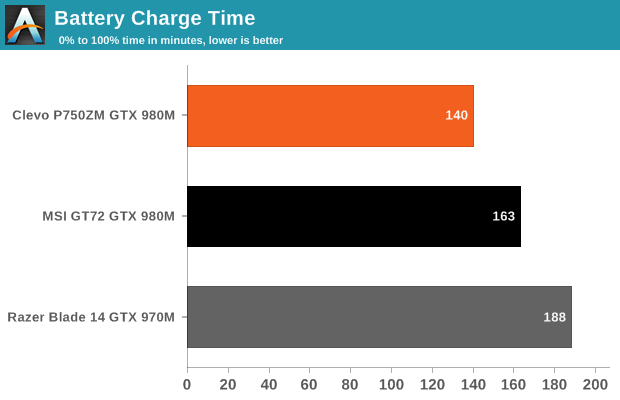Eurocom P5 Pro / Clevo P750ZM Review: True DTR
by Jarred Walton on March 10, 2015 10:00 AM ESTClevo P750ZM Battery Life and Power
Battery life is one area where the P750ZM really falls short, but we knew that going before even testing. MSI’s GT72 at least has the option to switch to Intel’s HD 4600 Graphics and can hit 5+ hours; with a desktop CPU and no integrated GPU option, P750ZM has no chance of doing much more than an hour and a half of mobility. It’s a case of going after performance at the cost of battery life.





As expected, the P750ZM ends up offering the worst battery life of any notebook we’ve tested in the past couple of years. Even the Alienware 18 wins by a large margin, as it can be manually switched to integrated graphics. We ended up just shy of two hours in our Light workload, and nearly 1.75 hours in our Heavy testing. If you were to get a 1080p display instead of the 4K IGZO, you could probably break two hours on the P750ZM but not by much.
We also did a test of gaming battery life; interestingly, it appears that Battery Boost works, and not only that but it was forced on when we tested. Disabling Battery Boost had no impact, and the FPS target was stuck at 30. Newer drivers may have addressed this issue, but the only thing that would happen is that battery life would go down. With a 30FPS target running Tomb Raider at 1080p Ultimate settings, we measured battery life of one hour. Battery recharge time was 140 minutes, which is pretty good for an 82Wh battery.
Switching over to power draw, even at idle the P750ZM shows close to 40W power draw at the outlet, which basically reinforces the above results. Things change a bit on battery power, but in the Light test the P750ZM uses ~42W (give or take) and ~47W in the Heavy workload. Plugged in and running games, however, the power draw can easily crest 200W sustained.










74 Comments
View All Comments
JarredWalton - Tuesday, March 10, 2015 - link
http://ark.intel.com/products/80807/Intel-Core-i7-...And yes, there are non-desktop CPU notebooks from Clevo, though they're not identical to the P750ZM. The Eurocom M5 Pro is based on the Clevo P650SE chassis and has specs similar to the Gigabyte P35W v3 -- Optimus (I believe), i7-4710HQ, GTX 980M.
http://www.eurocom.com/ec/configure(2,257,0)ec
will54 - Wednesday, March 11, 2015 - link
though I think the P650 solders there cpu and gpu on the mainboard so there is a tradeoff.Khenglish - Tuesday, March 10, 2015 - link
The reason why this laptop exists is because Intel is no longer selling socketed mobile processors. MSI, Alienware, and ASUS all went full BGA cpus for their entire lineup. Clevo did this for most laptops, but has this laptop to corner the entire socketed market all to itself.The only issue I see with this is the heatspreader. Haswell's heatspreader is not good at all, and this shows in the CPU vs GPU temps. In the P750zm there is a heatpipe connecting the GPU and CPU heatsinks, so a difference of more than ~10C should never happen.
JarredWalton - Tuesday, March 10, 2015 - link
Keep in mind that i7-4790K is technically Devil's Canyon, and part of the difference was a change in the Thermal Interface Material:http://www.anandtech.com/show/8227/devils-canyon-r...
Stuka87 - Tuesday, March 10, 2015 - link
The 4790K is an 88W chip. The 4790S is a 3.2GHz part. The 4790K is a 4GHz part. The 4790K is a desktop chip, not a mobile chip.Samus - Tuesday, March 10, 2015 - link
The i5-4690k and i7-4790k are 88w parts. The previous "non devils canyon" parts (4670k, 4770k) were 84w. The "Xeon" equivalent of these chips, ie, the E3-1230v3, is 80w.That is TDP. It doesn't mean the chips use 88w. It simply means they are manufactured to handle a higher temperature (tweaked power delivery on the packaging, better thermal insulation, etc) and even if not overclocked, this means they will turbo up to higher frequencies and for longer periods of time.
And considering the IGP isn't even being used (that's 1/4th the die area of Haswell) there is a lot of cooling headroom since many transistors aren't even being used. Typically these chips will use around 70w at stock load without the IGP enabled.
warmon6 - Wednesday, March 11, 2015 - link
Er... the desktop 4790k is 88W.And for dekstop-replacement laptops this is pretty tame vs the LGA 1366 desktop cpu that were in these kinds of laptop's when I last payed attention to them and last i remember all the core i7 1366 cpu's were 130W chips.
(and I would easly guess there are LGA 2011 and 2011-3 base laptops as well out there.)
hyno111 - Tuesday, March 10, 2015 - link
I'm waiting to see how 65w broadwell CPU performs on this beast...JarredWalton - Tuesday, March 10, 2015 - link
You'll need a new chipset and motherboard, so it will probably be in the P751ZM or something like that. From what I've seen, Broadwell will be about 5% faster at the same clocks compared to Haswell.Telemachus13 - Wednesday, March 11, 2015 - link
Why would a new chipset be needed? It was my understanding that Z97 supported Broadwell.Also, P751ZM is already the name of the European version.